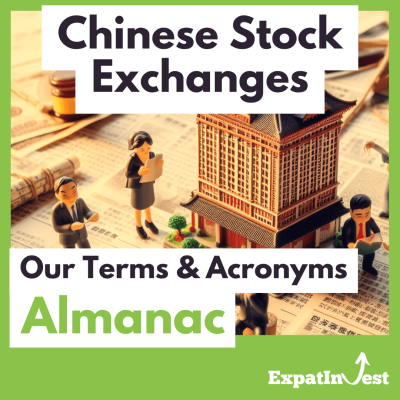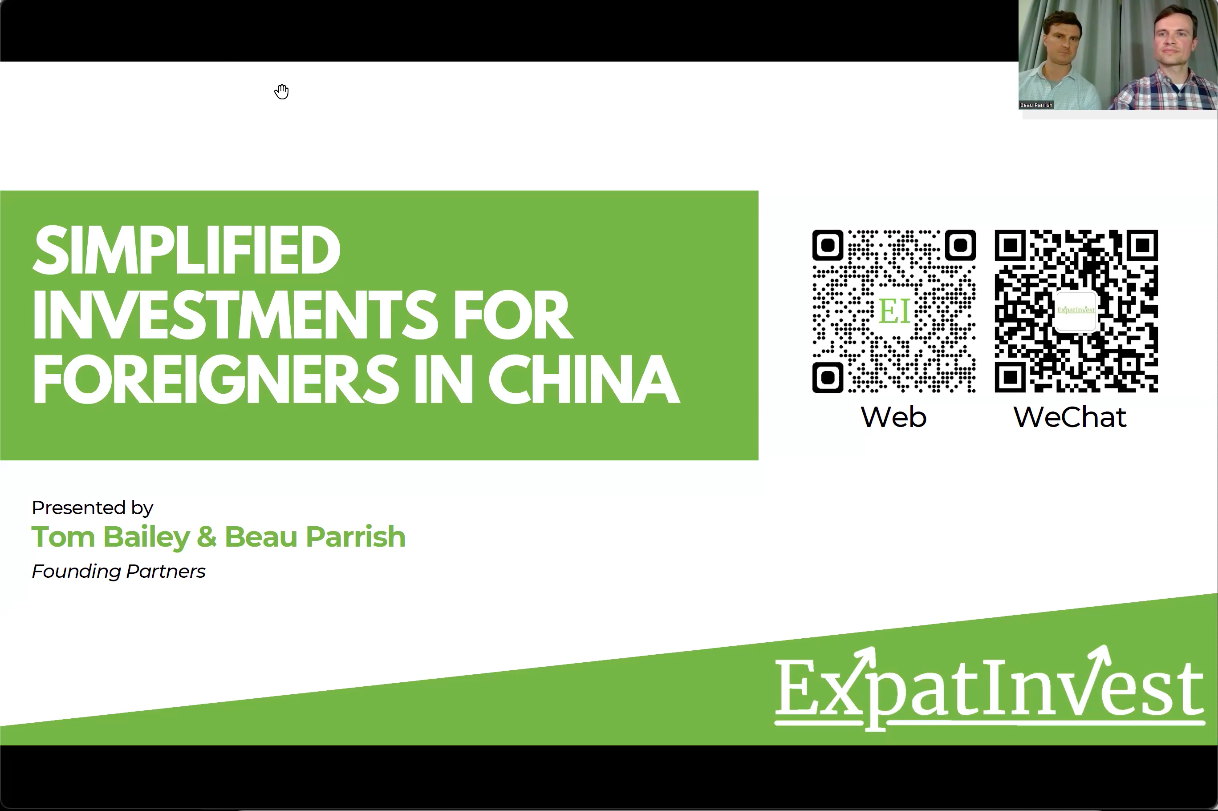
The Chinese financial markets have become some of the largest in the world, and certainly the fastest growing throughout the history of all markets.
Today we cover the unique terms and acronyms used in these markets. Over the years of being in China, I keep finding myself taking too much time to hunt down what a referred-to term means, or exactly what an acronym is referring to. Here’s an attempt to organize them into one clean bulletin!
Please note that I’m primarily covering terms related to the 2 main exchanges in mainland China: The Shanghai Stock Market (SSE) and the Shenzhen Stock Market (SZSE).
This article does not currently focus on The Beijing Stock Market (BSE), Hong Kong, Taiwan, or any other markets in Asia. That’s a project for another day 🙂
Ok, you’re right – let’s get to the terms already!
China's 'Big 2' Stock Markets:Terms and Acronyms
Terms are listed alphabetically.
Table of Contents
A shares
China A-shares are shares of mainland China-based companies that are traded on the Shanghai Stock Exchange (SSE) and the Shenzhen Stock Exchange (SZSE).
A-shares trade in Chinese Yuan (¥ RMB). B-shares trade in other currencies such as $ USD. They are primarily available for purchase by mainland Chinese investors.
Certain foreign institutional investors can also access A-shares through specific programs such as the Qualified Foreign Institutional Investor (QFII) scheme and the Stock Connect programs linking the mainland exchanges with the Hong Kong Stock Exchange.
- Read more: Investopedia, Wikipedia
B shares
China B-shares are shares of mainland China-based companies that are traded on the Shanghai Stock Exchange (SSE) and the Shenzhen Stock Exchange (SZSE).
A-shares trade in Chinese Yuan (¥ RMB). B-shares trade in other currencies such as $ USD.
B-shares were initially created to attract foreign investment, but they are also available to domestic investors who have foreign currency accounts. B-shares provide a means for foreign investors to invest in Chinese companies without the restrictions typically associated with A-shares.
- Read more: Investopedia, Wikipedia
ChiNext
The ChiNext is a stock market index under the Shenzhen Stock Exchange launched in 2009. The index focuses on providing a public board for tech businesses, similar to the NASDAQ in the US. As of early 2024, there were 1,337 companies listed on the ChiNext.
CSI
CSI stands for China Securities Index (company). The China Securities Index company is an Index provider, bond valuer, and credit rating agency. The main CSI stock indexes are listed just below.
- Read more: CSI website, Our CSI Guide, Wikipedia
- CSI 300 Index
The CSI 300 is the most well-known and widely used stock market index in the mainland Chinese markets. The index models the S&P 500 in the US.
It tracks the top 300 stocks in the Shanghai and Shenzhen stock exchanges. These 300 stocks are weighted according to the total market value of their outstanding shares.
- Read more: CSI website, Our CSI 300 Guide, Wikipedia
- CSI 50, 100, 500, 1000, etc Indices
Just like the CSI 300 Index above, these indices track the top 50/100/500/1,000/etc stocks in the Shanghai and Shenzhen stock exchanges. Again, stocks are weighted according to the total market value of their outstanding shares.
CSRC
The China Securities Regulatory Commission (CSRC) is the primary regulatory body responsible for overseeing and regulating the securities industry in China.
Established in 1992, the CSRC’s main functions include formulating securities regulations, supervising securities markets, ensuring fair and transparent market practices, protecting investors’ rights and interests, and maintaining the stability and integrity of the capital markets.
The CSRC regulates stock exchanges, securities companies, fund management firms, and other market participants.
- Read more: CSRC website
H shares
China H-shares are shares of mainland China-based companies that are traded on the Hong Kong Stock Exchange (HKEX).
These shares are denominated in Hong Kong dollars (HKD) and are available to both international and domestic investors. H-shares offer a way for Chinese companies to raise capital from international markets while providing global investors access to China’s economy.
They are subject to the regulatory requirements of the Hong Kong market, which are often considered more stringent than those in mainland China. H-shares are a key component of the broader China equity market, complementing A-shares and B-shares.
- Read more: Investopedia, Wikipedia
MSCI Emerging Markets Index
The MSCI Emerging Markets Index is a widely recognized benchmark that tracks the performance of large and mid-cap companies across 24 emerging market countries, including China.
The index is designed to represent the equity market performance of emerging economies, providing a comprehensive gauge for international investors. China equities makes up around 27% of the index as of May 2024.
- Read more: Index Overview from MSCI, Wikipedia (good section on China).
PBOC (People's Bank of China)
The People’s Bank of China (PBOC) is the central bank of the People’s Republic of China, responsible for monetary policy, regulation of financial institutions, and maintenance of financial stability. It was established on December 1, 1948.
China’s central bank works in coordination with other regulatory bodies, such as the China Banking and Insurance Regulatory Commission (CBIRC) and the China Securities Regulatory Commission (CSRC), to oversee the financial system comprehensively.
- Read more: Wikipedia
QFII & RQFII:
The Qualified Foreign Institutional Investor (QFII) and the Renminbi Qualified Foreign Institutional Investor (RQFII) programs are regulatory frameworks established by the Chinese government to facilitate foreign investment in China’s domestic capital markets.
The QFII program, launched in 2002, allows licensed foreign investors to invest in China’s mainland stock exchanges. The program aims to attract long-term foreign investments and enhance the sophistication of China’s financial markets by allowing experienced international investors to participate.
The RQFII program, launched in 2011, extends the principles of the QFII program by allowing foreign institutional investors to use offshore Renminbi (RMB) to invest in mainland China’s financial markets. This program was designed to internationalize the RMB and promote the use of the Chinese currency globally.
- Read more: SZSE website, Investopedia
Red Chips, P-chips, N-shares
From Yahoo! Finance’s nice guide to China share classes,
Red chips: State-owned Chinese companies incorporated outside the mainland (mostly in Hong Kong) and traded in Hong Kong.
P-chips: Nonstate-owned Chinese companies incorporated outside the mainland, most often in certain foreign jurisdictions (Cayman Islands, Bermuda, etc.) and traded in Hong Kong.
N-shares: Chinese companies incorporated outside the mainland, most often in certain foreign jurisdictions, and U.S.-listed on the NYSE or Nasdaq (ADRs of H-shares and red chips are also sometimes referred to as N-shares).
SSE
The Shanghai Stock Exchange. China’s flagship financial market is made up of the country’s largest corporations – particularly in industries such as finance, telecom, and insurance. It is Asia’s largest Stock Market and the world’s third-largest by market cap.
The exchange is home to the STAR Market (below), which (like ChiNext in Shenzhen) is similar to NASDAQ in the United States. Both focus on high-growth and high-tech firms.
- Read more: SSE Website, Our SSE Guide, Wikipedia
- SSE Composite Index
The SSE Composite Index (also known as the SSE Index) is a stock market index of all stocks that are traded at the Shanghai Stock Exchange.
- Read more: Investopedia, Wikipedia
- SSE 50 Index
The SSE 50 Index is a stock market index that represents the top 50 companies by market capitalization listed on the Shanghai Stock Exchange (SSE).
The index is designed to reflect the performance of the most significant and liquid stocks in the Chinese market, providing a benchmark for investors and a reference for index-based investment products.
The SSE 50 Index includes a diverse range of industries, covering sectors such as finance, energy, telecommunications, and consumer goods. It is widely used by fund managers and investors to gauge the overall health of the Chinese equity market and to make informed investment decisions.
- Read more: SSE website, Wikipedia
- SSE 180 Index
The SSE 180 Index is a stock market index that tracks the performance of the 180 largest and most liquid companies listed on the Shanghai Stock Exchange (SSE).
It aims to provide a comprehensive benchmark for the broader market (vs the SSE 50) by including a wide range of industries and sectors.
The SSE 180 Index is also used by investors and fund managers as a gauge of the overall market conditions in China and as a basis for index-linked investment products.
- Read more: SSE website, Wikipedia
- Other SSE Indices
While the 3 listed above are the most tracked, there are A LOT of other official indices on the Shanghai Stock Exchange! The exchange’s website does a simple & straightforward breakdown of each, and quite well: SSE Website – Indices List.
Index Name | Code | First Trading Day | Base Value |
|---|---|---|---|
| SSE Index | 000001 | 19 Dec 1990 | 100 |
| A Share Index | 000002 | 19 Dec 1990 | 100 |
| B Share Index | 000003 | 21 Feb 1992 | 100 |
| SSE 380 | 000009 | 31 Dec 2003 | 1000 |
| SSE 180 | 000010 | 28 Jun 2002 | 3299.06 |
| SSE 50 | 000016 | 31 Dec 2003 | 1000 |
| New SSE Index | 000017 | 30 Dec 2005 | 1000 |
| SSE Medium Composite | 000020 | 28 Dec 2007 | 1000 |
| SSE Mega-cap | 000043 | 31 Dec 2003 | 1000 |
| SSE MID CAP | 000044 | 31 Dec 2003 | 1000 |
| SSE SMALL CAP | 000045 | 31 Dec 2003 | 1000 |
| SSE MID&SMALL CAP | 000046 | 31 Dec 2003 | 1000 |
| SSE TOTAL MARKET | 000047 | 31 Dec 2003 | 1000 |
| SSE Free Float | 000090 | 31 Dec 2009 | 1000 |
| SSE 100 | 000132 | 31 Dec 2003 | 1000 |
| SSE 150 | 000133 | 31 Dec 2003 | 1000 |
| Market Value Top 100 | 000155 | 31 Dec 2003 | 1000 |
| STAR 50 | 000688 | 31 Dec 2019 | 1000 |
| STAR 100 | 000698 | 31 Dec 2019 | 1000 |
STAR Market
The Shanghai STAR Market (SSE STAR) is a modern stock market that is often compared to NASDAQ in the US. It is a market component of the larger Shanghai Stock Exchange (SSE, above), and primarily holds Science and Technology companies.
- Read more: STAR Market Website, Our STAR Market Guide, Wikipedia
- STAR 50 Index
The most common way to track SSE STAR Market is via SSE STAR 50 Index. This index tracks the top 50 stocks on the STAR market (ranked by market cap).
- Read more: STAR 50 Historical Returns (Investing.com)
- STAR 100 Index
Another way to track SSE STAR Market is via SSE STAR 100 Index. This index tracks the top 100 stocks on the STAR market (ranked by market cap). It was announced in July 2023.
- Read more: STAR 100 announcement (via STAR website)
Stock Code (6 digits in China)
A “6-digit stock code” in the context of Chinese stock exchanges refers to the numerical codes assigned to publicly traded companies listed on the Shanghai Stock Exchange (SSE) and the Shenzhen Stock Exchange (SZSE). These codes are used to uniquely identify each stock, simplifying trading and tracking.
- Shanghai Stock Exchange (SSE): On the SSE, stock codes typically start with the digits 600, 601, 603, or 605. For example, a company listed on the SSE might have a stock code like 600000 or 601988.
- Shenzhen Stock Exchange (SZSE): On the SZSE, stock codes often begin with the digits 000, 001, 002, 003, or 300. For instance, a stock might have a code like 000001 or 300750.
SZHK Stock Connect
The SZHK Stock Connect, also known as the Shenzhen-Hong Kong Stock Connect, is a cross-border trading program that enables investors in Mainland China and Hong Kong to trade eligible shares listed on each other’s stock exchanges through their local securities firms.
Launched on December 5, 2016, the program aims to enhance market connectivity between the Shenzhen Stock Exchange (SZSE) and the Hong Kong Stock Exchange (HKEX), promoting mutual market access and further integrating China’s capital markets with international markets.
Read more: SZSE website, Wikipedia
SZSE
The Shenzhen Stock Market (SZSE) was established on December 1, 1990, and is located in Shenzhen, Guangdong.
The SZSE lists shares of companies based in China and provides a platform for trading a variety of financial instruments, including A-shares, B-shares, mutual funds, fixed-income products, and derivatives.
The exchange is home to the ChiNext market (above), which is similar to NASDAQ in the United States. Both focus on high-growth and high-tech firms.
The SZSE aims to support the development of small and medium-sized enterprises (SMEs). Its sister market, the Shanghai Stock Exchange (SSE) primarily focuses on China’s large corporations.
- Read more: SSE website, Our SZSE Guide, Wikipedia
- SZSE Component Index (500)
The SZSE Component Index, also known as the Shenzhen Component Index, is a stock market index that tracks the performance of the 500 largest and most liquid companies listed on the Shenzhen Stock Exchange (SZSE). This index is considered a benchmark for the overall performance of the Shenzhen market, reflecting the market’s composition and trends.
The SZSE Component Index includes a wide range of sectors, with a significant focus on technology, manufacturing, and consumer goods, which are representative of the economic structure and growth drivers of the Shenzhen region. The index is calculated based on a free-float market capitalization-weighted methodology, ensuring that the influence of each constituent stock on the index is proportional to its market value.
The index serves multiple purposes, including benchmarking fund performance, guiding investment strategies, and providing insights into the economic health of the companies listed on the SZSE. It is also used as the basis for various financial products such as mutual funds and exchange-traded funds (ETFs).
- Read more: SZSE Component Index Holdings, Wikipedia
- Other SZSE Indices
Just like the SSE above, the SZSE has a sizeable amount of indices in total. Below is a basic list of them. The exchange’s website breaks them out into further detail here: SZSE Indices List.
| Code | Index Name | Base Value Date | Base Value | First Trading Date |
|---|
| 399001 | Shenzhen Index | 1994-07-20 | 1000 | 1995-01-23 |
| 399002 | Shenzhen TRI | 1994-07-20 | 1000 | 1995-01-23 |
| 399003 | SZSE Component B | 1994-07-20 | 1000 | 1995-01-23 |
| 399004 | Shenzhen 100 TRI | 2002-12-31 | 1000 | 2003-01-02 |
| 399005 | SME 100 | 2005-06-07 | 1000 | 2006-01-24 |
| 399006 | ChiNext (above) | 2010-05-31 | 1000 | 2010-06-01 |
| 399007 | SZSE 300 | 2004-12-31 | 1000 | 2009-11-04 |
| 399008 | SME 300 | 2010-03-19 | 1000 | 2010-03-22 |
| 399009 | SZSE 200 | 2004-12-31 | 1000 | 2011-09-01 |
| 399010 | SZSE 700 | 2004-12-31 | 1000 | 2011-09-01 |
WFE
The World Federation of Exchanges (WFE) is a global industry association for exchanges and clearinghouses, established in 1961.
The WFE works “to support and promote the development of fair, transparent, and efficient markets.” Its activities include advocating for international regulatory standards, conducting industry research, and promoting best practices in market infrastructure.
The WFE has over 250 member exchanges including the New York Stock Exchange, Nasdaq, London Stock Exchange, Hong Kong Exchanges and Tokyo Stock Exchange.
China’s Shanghai Stock Exchange (SSE) and Shenzhen Stock Exchange (SZSE) are members of the WFE.
- Read more: Member Exchanges (WFE website),
Table of Contents
New here? ExpatInvest provides simplified fund investments for expats in China. Put your Yuan RMB to work in the markets without the hassle. Avoid complicated fees & lock-in periods. Buy & Sell on your schedule. Learn more.
Share this article:







